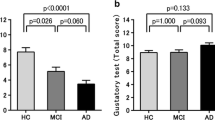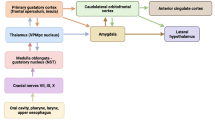Abstract
Objective
To evaluate the association between the severity of dementia and taste recognition abilities in older persons with Alzheimer’s disease (AD).
Methods
Anthropometric measurements were performed and body mass index was used to determine the nutritional status. The taste strips were used to test gustatory functions of the five basic tastes (sweet, salty, sour, bitter and umami).
Results
A total of 30 healthy younger subjects, 30 healthy older subjects, 37 with mild stage AD and 23 with moderate stage AD were recruited. The older subjects with moderate AD showed a significant reduction of taste, less recognition of bitter and salty taste (score: 10.6 ± 2.6; 2.6 ± 0.9; 1.7 ± 1.5) when compared to older people without cognitive impairment (score: 13.3 ± 1.8; 3.4 ± 0.9; 3.2 ± 0.9), and less recognition of sweet taste (score: 2.9 ± 1.2) when compared to subjects with mild stage AD (score: 3.6 ± 0.8). Impaired recognition of salty taste was detected since the early stages of AD. Among the factors that possibly influence gustatory function, a significant correlation was detected between taste ability and age, medication intake, mini-mental state examination and the nutritional status.
Conclusion
The severity of dementia is directly associated with greater impairment of taste sensitivity, especially among older subjects with moderate stage disease.
Similar content being viewed by others
References
Aprahamian I, Martinelli JE, Yassuda MS (2009) Doença de Alzheimer: revisão da epidemiologia e diagnóstico. Rev Bras Clin Med 7:27–35
LoGiudice D (2002) Dementia: an update to refresh your memory. Intern Med J 2:535–540
Marino LV, Ramos LF, Chiarello PG (2015) Nutritional status according to the stages of Alzheimer’s disease. Aging Clin Exp Res 27:507–513
Gillette-Guyonnet S, Abellan VKG, Alix E et al (2007) IANA (International Academy on Nutrition and Aging) expert group: weight loss and Alzheimer’s disease. J Nutr Health Aging 11:38–48
Inelmen EM, Sergi G, Coin A et al (2010) An open-ended question: Alzheimer’s disease and involuntary weight loss: which comes first? Aging Clin Exp Res 22:192–197
Guérin O, Andrieu S, Schneider SM et al (2005) Different modes of weight loss in Alzheimer disease: a prospective study of 395 patients. Am J Clin Nutr 82:435–441
Machado JS, Frank AA, Soares EA (2006) Fatores dietéticos relacionados à doença de Alzheimer. Rev Bras Nutr Clin 21:252–257
Campanella LCA, Farias MB, Breitkopf T et al (2007) Relação entre padrão alimentar e estado nutricional de idosos hospitalizados. Rev Bras Nutr Clin 22:100–106
Smith KL, Greenwood CE (2008) Weight Loss and nutritional considerations in Alzheimer Disease. J Nutr Elder 27:381–403
Koss E, Weiffenbach JM, Haxby JV et al (1988) Olfactory detection and identification performance are dissociated in early Alzheimer’s disease. Neurology 38:1228–1232
Schiffmann SS, Clark CM, Warwick ZS (1990) Gustatory and olfactory dysfunction in dementia: not specific to Alzheimer’s disease. Neurobiol Aging 11:597–600
Lang CJG, Leuschner T, Ulrich K et al (2006) Taste in dementing diseases and parkinsonism. J Neurol Sci 248:177–184
Steinbach S, Hundt W, Vaitl A et al (2010) Taste in mild cognitive impairment and Alzheimer’s disease. J Neurol 257:238–246
Ilhamto N, Duizer L (2010) Smell and taste recognition in early stages of late-onset Alzheimer’s disease. SURG 4:57–64
Ogawa T, Irikawa N, Yanagisawa D et al (2017) Taste detection and recognition thresholds in Japanese patients with Alzheimer-type dementia. Auris Nasus Larynx 44:168–173
Morris J (1993) The Clinical dementia rating (CDR): current version and scoring rules. Neurology 43:2412–2414
American Psychiatric Association (1994) Diagnostic and statistical manual of mental disorders (DSM-IV). Washington, DC
Schiffman SS (1997) Taste and smell losses in normal aging and disease. JAMA 278:1357–1362
Paula RS, Colares FCJ, Toledo JO et al (2008) Alterações gustativas no envelhecimento. Rev Kairós 11:217–235
Folstein MF, Robins LN, Helzer JE (1983) The mini-mental state examination. Arch Gen Psychiatr 40:812
World Health Organization (WHO) (1995) Physical Status: The Use and Interpretation of Anthropometry. (Technical Report Series, 854). Genebra
Organización Panamericana de la Salud. XXXVI Reunión del Comité Asesor de Investigaciones em Salud (2001) Encuesta multicentrica: salud, bien estar e envejecimento (SABE), em America Latina y el Caribe. Washington, DC
Rubenstein LZ, Harker JO, Salvà A et al (2001) Screening for undernutrition in geriatric practice: develo** the short-form mini-nutritional Assessment (MNA-SF). J Gerontol Med Sci 56:366–372
Mueller C, Kallert S, Renner B et al (2003) Quantitative assessment of gustatory function in a clinical context using impregnated “taste strips”. Rhinology 41:2–6
Vieira I, Fernandes A, Céspedes JM, Machado MÂ et al (2011) Taste evaluation in adolescents and pediatric patients with benign migratory glossitis. Int J Pediatr Otorhinolaryngol 75:1230–1233
Landis BN, Welge-Luessen A, Bramerson A et al (2009) ”Taste Strips”—a rapid, lateralized, gustatory bedside identification test based on impregnated filter papers. J Neurol 256:242–248
Satoh-Kuriwada S, Shoji N, Kawai M et al (2009) Hyposalivation strongly influences hypogeusia in the elderly. J Health Sci 55:689–698
Piovesana PM, Gallani MCBJ, Sampaio KL (2012) Revisão: metodologias para análise da sensibilidade gustativa ao sal. Braz J Food Technol 15:182–190
Drewnowski A, Gomez-Carneros C (2000) Bitter taste, phytonutrientes, and the consumer: a review. Am J Clin Nutr 72:1424–1435
Kaneda H, Maeshima K, Goto N et al (2000) Decline in taste and odor discrimination abilities with age, and relationship between gustation and olfaction. Chem Senses 25:331–337
Imoscopi A, Inelmen EM, Sergi G et al (2012) Taste loss in the elderly: epidemiology, causes and consequences. Aging Clin Exp Res 24:570–579
Boyce JM, Shone GR (2006) Effects of ageing on smell and taste. Postgraduate Med. J 82:239–241
Mistretta CM (1984) Ageing effects on anatomy and neurophysiology of taste and smell. Gerodontology 3:243–248
Faber J (2006) Avanços na compreensão do paladar. R Dental Press Ortodon Ortop Facial. Maringá 11:14
Murphy C (2008) The chemical senses and nutrition in older adults. J Nutr Elder 27:247–265
Doty RL, Shah M, Bromley SM (2008) Drug induced taste disorders. Drug Saf 31:199–215
Kucukdagli P, Bahat G, Bay I et al (2019) The relationship between common geriatric syndromes and potentially inappropriate medication use among older adults. Aging Clin Exp Res. https://doi.org/10.1007/s40520-019-01239-x
Sakai M, Kazui H, Shigenobu K et al (2017) Gustatory dysfunction as an early symptom of semantic dementia. Dement Geriatr Cogn Dis Extra 23:395–405
Sakai M, Ikeda M, Kazui H et al (2016) Decline of gustatory sensitivity with the progression of Alzheimer’s disease. Int Psychogeriatr 28:511–517
Suzuki Y, Yamamoto S, Umegaki H et al (2004) Smell identification test as an indicator for cognitive impairment in Alzheimer’s disease. Int J Geriatr Psychiatr 19:727–733
Tabert MH, Liu X, Doty RL et al (2005) A 10-item smell identification scale related to risk for Alzheimer’s disease. Ann Neurol 58:155–160
Kouzuki M, Suzuki T, Nagano M et al (2018) Comparison of olfactory and gustatory disorders in Alzheimer’s disease. Neurol Sci 39:321–328
Young KW, Greenwood CE, van Reekum R et al (2005) A randomized, crossover trial of high-carbohydrate foods in nursing home residents with Alzheimer’s disease: associations among intervention response, body mass index, and behavioral and cognitive function. J Gerontol A Biol Sci Med Sci 60:1039–1045
Ahmed RM, Irish M, Kam J et al (2014) Quantifying the eating abnormalities in Frontotemporal Dementia. JAMA Neurol 71:1540–1546
Fuchida S, Yamamoto T, Takiguchi T et al (2013) Association between underweight and taste sensitivity in middle- to old-aged nursing home residents in Sri Lanka: a cross-sectional study. J Oral Rehabil 40:854–863
Nordin S, Bramerson A, Bringlov E et al (2007) Substance and tongue-region specific loss in basic taste-quality identification in elderly adults. Eur Arch Otorhinolaryngol 264:285–289
Schiffman SS (2009) Effects of aging on the human taste system. Ann N Y Acad Sci 1170:725–729
Ali PA (2007) Managing under-nutrition in a nursing home setting. Nurs Older People 19:33–36
Ikeda K (2002) New seasonings. Chem Senses 27:847–849
Acknowledgements
The authors thank Priscila Cansian Rossin for the help in collecting data.
Author information
Authors and Affiliations
Corresponding author
Ethics declarations
Conflict of interest
The authors declare that they have no conflict of interest.
Ethical approval
All procedures performed in studies involving human participants were in accordance with the ethical standards of the Research Ethics Committee of the Hospital (Reference number: 7547/2014) and with the 1964 Helsinki declaration and its later amendments or comparable ethical standards.
Informed consent
Informed consent was obtained from all individual participants or formal representatives in the case of individuals with dementia included in the study.
Additional information
Publisher's Note
Springer Nature remains neutral with regard to jurisdictional claims in published maps and institutional affiliations.
Rights and permissions
About this article
Cite this article
Contri-Degiovanni, P.V., Degiovanni, G.C., Ferriolli, E. et al. Impact of the severity of dementia due to Alzheimer’s disease on the gustatory sensitivity of older persons. Aging Clin Exp Res 32, 2303–2309 (2020). https://doi.org/10.1007/s40520-019-01442-w
Received:
Accepted:
Published:
Issue Date:
DOI: https://doi.org/10.1007/s40520-019-01442-w




